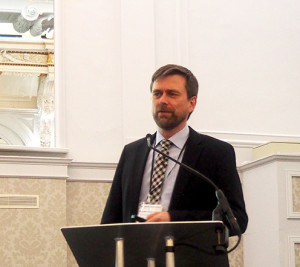Vishal Bansal, UK supply chain director of Amazon analysed the evolving marketplace of customers and new technology at the Logistics & Supply Chain Conference.

“Topic close to my heart – meeting customer demands as well as to improve operations,” said Bansal. He said that Amazon aims to be the earth’s most customer centric company, the retail giant wants customers not just to find products they like, but to discover things they didn’t know they wanted.
Just the sheer range of products is something Bansal thinks has been a big part of the success and growth at Amazon. The company is now growing 20 per cent plus every year – in 2015-2016 growth was equal to how big the company was in 2010.
“It’s not just about physical products, it’s also about processes,” said Bansal. “Lots of people talk about customer centric processes,” said Bansal. “I don’t think there are many who are absolutely obsessed with the customer and will do what it takes to delight the customer.”
According to Bansal, Amazon has a self-fulfilling cycle – it begins with the wide selection of products. Where customers have more choice they have a better experience, which attracts more customers, and then more suppliers. “Within operations it helps reduce cost structure as we get more volume – we use that to give lower prices,” added Bansal.
“The reason why we do innovation and do it well is because we are builders, everyone tends to be passionate about building something,” said Bansal. According to him, Amazon is always taking big risks, and always looking for the next innovation. Hence its big investment in robotics.
The three biggest benefits of robotics for Amazon, said Bansal, are that it helps employees because working with the latest technology makes work easier, it helps the business get its products to customers much faster, as well as getting products to customers much faster and making sure the business meets customer demand.
It enables us to keep a lot more stock and turn it around quicker than a traditional building, and supports and develops networks, said Bansal.
“Shelves are moved by robots for density and durability,” added Bansal. The associate can stay in one place.
Beyond the physical robots Amazon invests lots of time on supply chain optimisation technologies, and analyses millions of orders from 185 countries. The business is always developing intelligence systems to choose best suppliers, and optimise warehouses to more efficiently restore products – using every computer science tool.
The conference was opened with a keynote presentation by Christian Seemann, vice president supply chain management parts, MAN Truck & Bus AG, which beat off competition from companies of the calibre of Shell, John Lewis and Sky to take the overall award in the 2016 Supply Chain Excellence Awards.

Seemann explained how MAN has transformed its parts supply chain to give best in class performance using a strategy entitled “plan@parts”. MAN’s initiative to re-shape its spare-parts supply network, meant that it, rather than the dealers, would take responsibility for the planning and supply of spare parts to the dealerships. The plan would require the dealers to have the utmost level of trust in MAN’s ability to correctly predict demand for parts at the sharp end, within the dealerships themselves. The upshot was that MAN would manage the inventory held at each and every dealership. The dealers would need to be absolutely confident that their customers would not be let down.
The over-arching idea was to reduce the ‘bullwhip effect’ across the spare parts supply chain by gathering big data volumes from all the locations involved to create a holistic view of inventory needs.
Seemann pointed out that it was vital to have all the information about all the stakeholders in the network. You have to be aware of what your partners’ strategies are.

Private capital dealers account for two thirds of total dealer network, so it was essential to get their support. Wholly-owned service operations account for the other third.
In 2015 MAN rolled out the system in Germany with 145 dealers and last year it started on the integration of service partners in Europe.
The results have been dramatic: plan@parts has had a massive impact on improving availability. “Dealers told us it has had a high impact on customer satisfaction,” Seemann said.
Not only has it exceeded its availability targets – the system has given MAN best in class performance. Not only that, almost a quarter of VORs were eliminated.

Coventry.
The system is now being rolled out across the rest of Europe, and the UK will be one of the countries to get the new system in May of this year.
But it doesn’t stop there. Seemann said MAN is now looking at its planning process, moving from planning on a historical basis. The next step is prediction of spare part demand, using telematics to provide information directly from the vehicles.
This is all about big data – finding the right prediction method to give even better up-time on the vehicle. The vehicle could tell the driver that he needs to replace a brake pad within then next two hundred miles. It could even book the vehicle into the dealer.

In the second session of the morning, Alastair Charatan, supply chain director at SIG Distribution focused on Supply Chain Transformation, in particular building and executing an integrated supply chain strategy.






